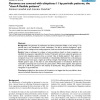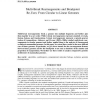BMCBI
2005
14 years 10 days ago
2005
Background: The genomes of prokaryotes and lower eukaryotes display a very strong 11 bp periodic bias in the distribution of their nucleotides. This bias is present throughout a g...
BMCBI
2005
14 years 10 days ago
2005
Background: Public databases now contain multitude of complete bacterial genomes, including several genomes of the same species. The available data offers new opportunities to add...
TCS
2008
14 years 10 days ago
2008
Genomes are dynamic molecules that are constantly undergoing mutations and rearrangements. The latter are large scale changes in a genome organisation that participate in the evol...
IJDMB
2007
14 years 10 days ago
2007
: Phylogenetic profiles of proteins strings of ones and zeros encoding respectively the presence and absence of proteins in a group of genomes have recently been used to id...
NAR
2006
14 years 11 days ago
2006
The Yeast Gene Order Browser (YGOB) is an online tool designed to facilitate the comparative genomic visualization and appraisal of synteny within and between the genomes of seven...
NAR
2006
14 years 11 days ago
2006
The University of California Santa Cruz Genome Browser Database (GBD) contains sequence and annotation data for the genomes of about a dozen vertebrate species and several major m...
NAR
2006
14 years 11 days ago
2006
The Chloroplast Genome Database (ChloroplastDB) is an interactive, web-based database for fully sequenced plastid genomes, containing genomic, protein, DNA and RNA sequences, gene...
JEA
2008
14 years 12 days ago
2008
As more and more genomes are sequenced, evolutionary biologists are becoming increasingly interested in evolution at the level of whole genomes, in scenarios in which the genome e...
JCO
2008
14 years 12 days ago
2008
In this paper we present two main results about the inapproximability of the exemplar conserved interval distance problem of genomes. First, we prove that it is NP-complete to deci...
JCB
2008
14 years 12 days ago
2008
Multi-break rearrangements break a genome into multiple fragments and further glue them together in a new order. While 2-break rearrangements represent standard reversals, fusions...





